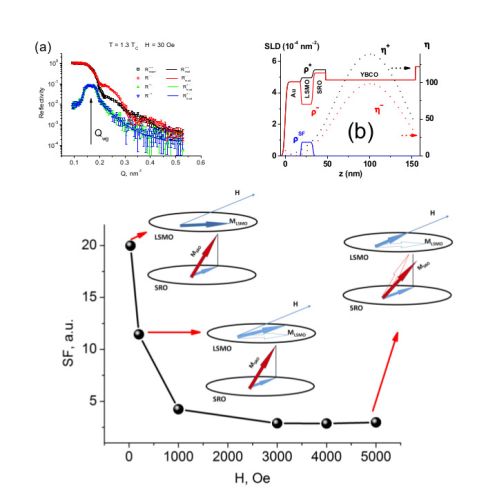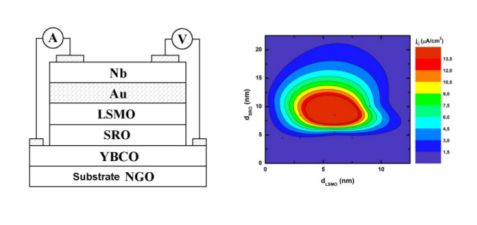MLZ is a cooperation between:
 > Technische Universität München
> Technische Universität München > Helmholtz-Zentrum Hereon
> Helmholtz-Zentrum Hereon
 > Forschungszentrum Jülich
> Forschungszentrum Jülich
MLZ is a member of:
 > LENS
> LENS > ERF-AISBL
> ERF-AISBL
MLZ on social media:

MLZ (eng)
Lichtenbergstr.1
85748 Garching
Triplet Superconducting Correlations in Oxide Heterostructures with Noncollinear Magnetization
Yu. N. Khaydukov1,4,6, G. A. Ovsyannikov2,3, A. E. Sheyerman2, K. Y. Constantinian2, L. Mustafa1, T. Keller1,4, M. A. Uribe-Laverde5, Yu. V. Kislinskii2, A. V. Shadrin2,3, A. Kalabukhov3, B. Keimer1, D. Winkler3
1Max Planck Institute for Solid State Research, Stuttgart, Germany
2Kotel’nikov Institute of Radio Engineering and Electronics of Russian Academy of Sciences, Moscow, Russia
3Department of Microtechnology and Nanoscience, Chalmers University of Technology, Gothenburg, Sweden
4Max-Planck-Institute for Solid State Research at MLZ, Garching, Germany
5Department of Physics and Fribourg Centre for Nanomaterials, University of Fribourg, Fribourg, Switzerland
6Skobeltsyn Institute of Nuclear Physics, Moscow State University, Moscow, Russia
*Coexistence of ferromagnetic and superconducting order rarely occurs because of the antagonistic nature of the two phenomena. The strong exchange coupling in ferromagnets tries to align electron spins in parallel, incompatible with antiferromagnetically aligned spins of a Cooper pair. This conflict can be resolved in the case of triplet superconductivity where electron pairs with parallel spins are not destroyed by the exchange field of ferromagnets [1].
In this work, we have studied triplet superconducting correlations in all-oxide heterostructures composed of ferromagnetic La0.7Sr0.3MnO3, SrRuO3 and superconducting YBa2Cu3Ox using SQUID, PNR and transport measurements [2].*
Sample preparation and neutron scattering
Heterostructures with composition La0.7Sr0.3MnO3/SrRuO3/YBa2Cu3Ox (LSMO/SRO/YBCO) were fabricated on (110) NdGaO3, (001) LaAlO3 or (001) (LaAlO3)0.3(Sr2AlTaO6)0.7 substrates by pulsed laser ablation and then covered in-situ by Au films. Square mesa-structures with in-plane size L=10-50 μm were fabricated on NdGaO3 substrates [3].
The PNR experiment was conducted on the reflectometer NREX. A polarized neutron beam with wavelength 4.26 Å and 99.99% polarization falls on the sample under the grazing incidence angles θ1 = [0.15 – 1]. The divergence of the beam Δθ1 = 0.025° was set by two slits in front of the sample. The polarization of the reflected beam was analyzed by a polarization analyzer with 98% efficiency. An in-plane magnetic field was applied parallel to the one edge of the sample. Before the measurements, the sample was cooled down to T = 80K in H =5 kOe to align the magnetic domains in the direction parallel to the external field. Subsequently, the magnetic field was decreased to H = 30 Oe and reflectivity curves were measured.
Spin-polarized reflectivity curves taken at T = 80 K are shown in Fig. 1a. The NSF curves R++ and R— are characterized by total reflection from the substrate with critical wave vector transfer Qcrit = 0.15 nm-1 and Kiessig fringes. The difference between R++ and R— indicates the presence of a collinear component of the magnetization. The SF scattering, in turn, shows that an in-plane non-collinear component of the magnetization exists. The sharp peaks in the SF channels around Qcrit with intensity of about 10% originate from the waveguide-like structure formed by capping the system with the layer of gold. The parameters of this peak (width, height and area) are very sensitive to the magnetic state of the system [4]. In particular, the magnetic field dependence of the peak area is shown in Fig. 1c. One can see that the intensity of SF scattering is rapidly decreased in the range of magnetic field H = [0-1] kOe and stays almost zero at magnetic fields up to H = 5kOe. The sensitivity of the waveguide SF peak is explained by significant enhancement of neutron density in the waveguide mode. According to our calculations [2], the neutron density in the vicinity of the magnetic layers is enhanced by a factor of 20-30 with respect to the intensity of the incoming beam (Fig. 1a), thus allowing the sensitivity of PNR in the determination of the in-plane non-collinear moment to be significantly increased.
Analysis of PNR and SQUID data allowed us to restore field evolution of the 3D vector profile of the magnetic sub-system (see insets in Fig. 1c). In small magnetic fields (order of tens of Oersteds) magnetic moment of LSMO layer 3.2μB/Mn lies in- plane along the easy axis, which made an angle of 45° with respect to the direction of external field. The magnetic moment of SRO 1.3 μB/Ru is inclined on angle 80° to the sample plane (left inset in Fig. 1c). The subsequent increase of the external magnetic field to H ~ 1kOe leads to a rotation of the LSMO magnetization vector towards the magnetic field, while the direction of the SRO magnetization remains the same (middle inset in Fig. 1c). The magnetic field of half a Tesla was enough to align moments of LSMO and SRO collinear (right inset in Fig. 1c). Thus, a combination of PNR and SQUID allowed us to experimentally prove that the non-collinear alignment of the LSMO and SRO magnetization vectors remains virtually unchanged in the range of applied magnetic fields H = [0÷5] kOe that enables generation of a triplet condensate.
Transport measurements
To probe possible triplet superconducting correlations in the ferromagnetic layers, a mesa-structure with two superconducting electrodes was studied (Fig. 2). The second electrode was a Nb film deposited on top of the Au/LSMO/SRO/YBCO structure [3]. A superconducting current was observed in all mesa-structures with LSMO/SRO total thickness dM = dLSMO + dSRO up to 53 nm (Fig.2b), which is much larger than the coherence length of both ferromagnets ξF ~ 5nm [3]. The measurements also showed that a critical current exists even in the fields of several kOe. It would be surprising for a singlet superconducting current to exist at H fields up to 100 times stronger than the period of critical current oscillation (~10 Oe). As was directly shown by PNR and SQUID measurements, the presence of critical currents at such high magnetic fields is explained by strong non-collinear alignment of magnetic moments of LSMO and SRO layers.
Conclusion
We have directly probed non-collinear magnetism on metal-oxide heterostructures by means of SQUID magnetometry and PNR. The dependence of the observed superconducting current in the mesa-structures Nb/Au/LSMO/SRO/YBCO on thicknesses of LSMO and SRO was studied and compared with theoretical predictions. The Josephson effect observed in these structures is explained by the penetration of the long-range triplet component of the superconducting correlations into the magnetic layer. Further work is required to elucidate the magnetic structures at the interfaces and their influence on the propagation of supercurrents, as well as the possible role of d-wave pairing.
References:
[1] F. S. Bergeret et al., Rev. Mod. Phys. 77, 1321 (2005).
[2] Y. N. Khaydukov et al., Phys. Rev. B 90, 035130 (2014).
[3] G. A. Ovsyannikov et al., J. Exp. Theor. Phys. Lett. 97, 145 ( 2013).
[4] Y. N. Khaydukov and Yu. V. Nikitenko, Nucl. Instum. Meth. A 629, 245 (2011).
MLZ is a cooperation between:
 > Technische Universität München
> Technische Universität München > Helmholtz-Zentrum Hereon
> Helmholtz-Zentrum Hereon
 > Forschungszentrum Jülich
> Forschungszentrum Jülich
MLZ is a member of:
 > LENS
> LENS > ERF-AISBL
> ERF-AISBL
MLZ on social media:




